The First German Single Malt Whisky Isn't As Old As You Might Expect

Despite having a long history of distillation spanning centuries, Germany is not typically associated with hard liquors and spirits like Scotland is with its scotches. In fact, you may be surprised to learn that German-branded single malts didn't hit the market until rather recently. Slyrs, a distillery nestled in the picturesque landscapes of Bavaria, introduced the first 1,600 bottles of German single malts to the market in 2002. To put things in perspective, Scotland has been producing malt whisky since the 15th century.
Historically, German distilleries were more known for producing fruit spirits, known locally as Obstler, and grain brandies, known as Korn. While some areas of Germany did produce whisky, it was on a smaller scale and often only served locally at the distilleries. So, Slyrs' foray into producing mass-market single malts caused quite a buzz in the industry. The initial bottles enjoyed considerable success and sold out in days, paving the way for further refinement of Slyrs' offerings. Today, Slyrs not only offers classic whisky but also a variety of single malts aged in different types of casks. Each provides a unique finish, from Oloroso sherry to American white oak casks that once held liqueur wine like Marsala. The interest in German single malts not only boosted Slyrs' business but also transformed the industrial landscape in Germany significantly. Today, there are over 300 whisky distilleries operating across the country!
Read more: The 25 Best Bourbon Brands, Ranked
How Germany Evolved From Distilling Fruit Spirits To Whisky

Since most German distillers had been focused on producing Obstler and Korn historically, early German whisky ran into lots of trouble in the transition. One obstacle they faced early on was the type of still they used. Traditional German stills designed for fruit spirits were long and featured multiple levels inside. While these stills were excellent for producing fruity flavors, they weren't great for Scotch-style whisky. Slyrs initially used these fruit stills for the first few batches of single malts but swiftly switched to custom-made stills that resembled the round pot stills used in Scotland after the brand proved profitable. This shift resulted in whisky with a more complex taste profile.
Apart from production, German distillers also had to get crafty when it came to the maturation process. For example, Slyrs went through trial and error to figure out how to avoid imbuing the liquor with overpowering woodsy notes. Too much woodiness would transform the whisky into something resembling bourbon, which wasn't the goal.
Read the original article on Tasting Table.


